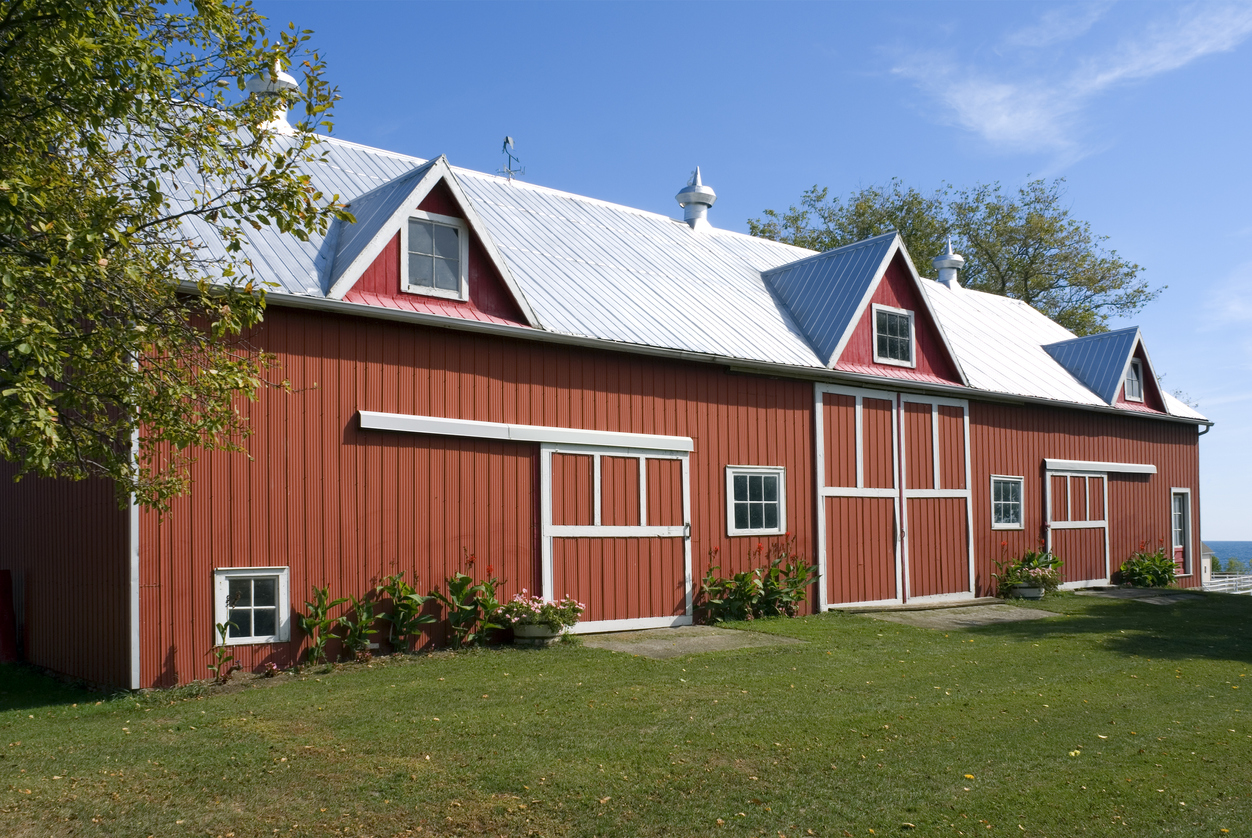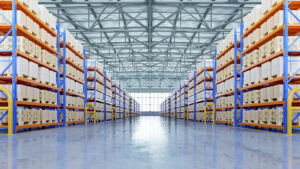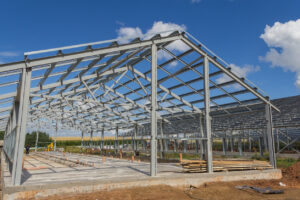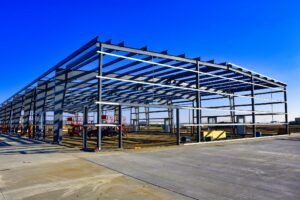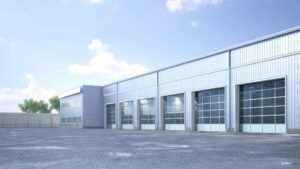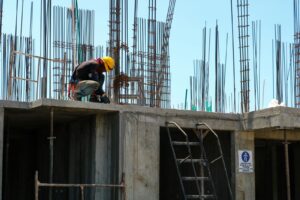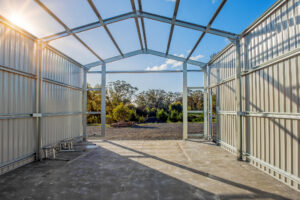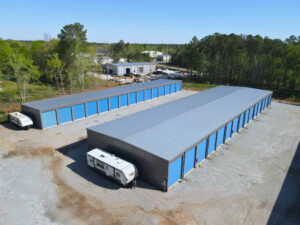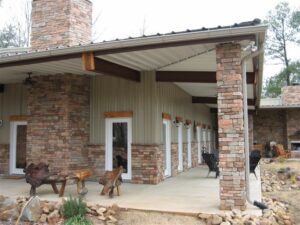Warehouse construction is a complex process that involves various factors and considerations. Understanding the basics of warehouse construction and the associated costs is crucial when planning such a project.
In 2021, the U.S. warehousing and storage industry generated a substantial revenue of almost $50.5 billion. This industry has exhibited steady growth, with an average annual growth rate of 2.8% between 2017 and 2022.
This growth can be attributed to the rise of e-commerce and the increasing consumer demand for fast and efficient delivery services.
Looking ahead, the warehousing and storage market size in the U.S. is projected to experience continued growth. It reached $505.1 billion in 2023 and is expected to grow to $700.2 billion by 2032, with a compound annual growth rate (CAGR) of 3.5% from 2024 to 2032. This positive outlook reflects the industry’s critical role in the global supply chain and the ongoing expansion of online retailing.
In this article, we will delve into the key aspects of warehouse construction costs and explore strategies to save money along the way.
Table of Content:
- Understanding the Basics of Warehouse Construction
- Breaking Down the Costs of Building a Warehouse
- The Role of Warehouse Size and Design in Cost
- Additional Costs in Warehouse Construction
- Cost-saving Strategies for Warehouse Construction
- What’s next?
- Frequently Asked Questions
Understanding the Basics of Warehouse Construction
The Importance of a Warehouse in Business
A warehouse serves as the logistical hub for many businesses, providing storage and distribution facilities. It plays a vital role in ensuring a smooth supply chain, efficient inventory management, and timely delivery of goods to customers. With an increasing demand for faster order fulfillment and better inventory control, the need for warehouses continues to rise.
Warehouses are not merely storage spaces; they are dynamic environments where goods are received, sorted, stored, and shipped out efficiently.
Modern warehouses are equipped with advanced technologies such as automated storage and retrieval systems, barcode scanners, and inventory management software to streamline operations and improve productivity.
Key Factors in Warehouse Construction
Before diving into the costs involved, it is essential to consider several key factors that impact warehouse construction:
- Location: The geographic location of the warehouse influences land costs, transportation expenses, and availability of labor.
- Size and design: The size and layout of the warehouse directly affect the construction costs, as larger facilities require more materials and labor.
- Regulatory compliance: Adherence to building codes, fire safety regulations, and other legal requirements can impact construction costs.
Another key factor to consider in warehouse construction is sustainability. As environmental concerns become more prominent, many businesses are opting for eco-friendly warehouse designs that incorporate energy-efficient lighting, solar panels, and rainwater harvesting systems. These sustainable features not only reduce operational costs in the long run but also demonstrate a commitment to environmental stewardship.
Breaking Down the Costs of Building a Warehouse
Land Acquisition and Site Preparation Costs
The first step in warehouse construction is acquiring suitable land. Land prices vary widely based on location and accessibility to transportation networks. Factors such as proximity to major highways, ports, and railroads can increase land costs but provide strategic advantages for distribution and logistics operations. In addition to land acquisition, site preparation costs are crucial to consider. This includes expenses for clearing the land, grading the site for construction, and connecting utilities such as water, electricity, and sewage.
Proper site preparation is essential for a smooth construction process and can impact the overall timeline and budget of the project.
Construction and Material Costs
The construction phase encompasses various expenses, with material costs being a significant factor. The choice of construction materials can impact the warehouse’s longevity, maintenance requirements, and overall cost. For example, steel structures are known for their durability and strength, making them a popular choice despite their higher initial cost, which usually depends on the level of customization.
70% of steel produced today within the United States is recycled.
Concrete is another common material used in warehouse construction due to its fire resistance and low maintenance needs. Wood, while cost-effective, may require more maintenance over time. Understanding the pros and cons of each material is crucial in determining the most suitable option for the project’s requirements and budget.
Pro tip:
Steel is an extremely strong building material. It’s possible to do clearspan construction, which means there’s no need to have load-bearing walls or columns to hold up a roof – the steel frame handles that on its own
Labor and Installation Costs
Efficient warehouse construction relies on skilled labor for various tasks, from design and planning to actual building. Architects and engineers are involved in the initial stages to create functional and safe warehouse designs, while construction crews execute the plans on-site.
Labor costs can vary based on the location of the project and the availability of skilled workers in the area. Additionally, the installation of equipment and systems within the warehouse adds to the overall expenses. This includes setting up racking systems for storage, HVAC systems for climate control, and electrical wiring for lighting and power distribution. Proper installation of these systems is essential for the warehouse’s operational efficiency and safety compliance.
The Role of Warehouse Size and Design in Cost
How Size Influences the Cost
The size of the warehouse has a direct impact on construction costs. Larger warehouses require more materials, extensive site preparation, and increased labor hours. On the other hand, smaller warehouses may suit the needs of certain businesses and present cost-saving opportunities. Determining the optimal size based on operational requirements is crucial to managing construction expenses effectively.
Did You Know?
A ballpark range to build a warehouse in the U.S. is approximately $110-150 per square foot (< 100k SF projects). However, it’s essential to note that this cost can vary significantly based on several factors, including size, type, design, materials, location, and use case
Moreover, the size of the warehouse also plays a vital role in operational efficiency. A larger warehouse allows for more storage space, potentially reducing the need for off-site storage facilities and streamlining inventory management processes.
However, a smaller warehouse might promote better organization and faster picking processes, depending on the nature of the business.
The Impact of Design on the Overall Cost
The design of the warehouse significantly affects both construction and operational costs. Efficient design maximizes space utilization, minimizes material waste, and optimizes workflow.
Implementing features such as high ceilings, mezzanines, and efficient floor plans can contribute to initial savings and long-term operational efficiency.
Furthermore, incorporating sustainable design practices, such as natural lighting, energy-efficient HVAC systems, and eco-friendly materials, can lead to cost savings over the lifespan of the warehouse. These environmentally conscious design choices not only reduce operational expenses but also enhance the overall sustainability and reputation of the business.
Additional Costs in Warehouse Construction
Warehouse Equipment and Technology Costs
In addition to the construction costs, warehouse owners should consider the expenses associated with equipping the facility. This includes the purchase or lease of handling equipment, forklifts, conveyors, and automated systems. Implementing advanced technologies, such as inventory management software and tracking systems, can enhance productivity but also add to the overall investment.
Furthermore, investing in energy-efficient equipment and technology can lead to long-term cost savings. Energy-efficient lighting, HVAC systems, and machinery not only reduce operational expenses but also contribute to sustainability efforts. Choosing environmentally friendly options may qualify for tax incentives or rebates, providing additional financial benefits in the long run.
Did You Know?
In the first quarter of 2023, some U.S. cities (Portland – Over $222.5 per square foot; and San Francisco: over $200 per square foot) had higher-than-average construction costs for industrial warehouses.
Safety and Security Measures Costs
The safety and security of a warehouse are of utmost importance. Installing appropriate fire suppression systems, security cameras, access control systems, and alarms is crucial. These measures not only safeguard the goods stored within but also ensure the well-being of personnel. These measures can contribute to higher overall construction costs.
Worth mentioning is the use of steel as a non-combustible material in warehouse construction. In the case of a fire, the steel frame, wall panels, and ceiling panels won’t burn like those made of wood, making steel buildings safer in the event of a fire.
Also,investing in training programs for employees on safety protocols and emergency procedures is essential. Well-trained staff can prevent accidents, minimize downtime, and improve overall operational efficiency. While this may incur initial training costs, the long-term benefits in terms of reduced incidents and increased employee morale are invaluable.
Cost-saving Strategies for Warehouse Construction
Efficient Design and Planning
Investing time and resources in efficient design and planning can lead to significant cost savings. Engaging experienced architects and designers who specialize in warehouse projects can help optimize the layout, minimize material waste, and improve overall energy efficiency.
Emphasizing sustainable practices, such as incorporating natural lighting and insulation, can also reduce long-term operational costs.
Furthermore, when designing a warehouse, it is essential to consider future expansion possibilities. Planning for scalability from the initial stages can prevent costly modifications or additions later on.
By incorporating flexible design elements, such as adjustable racking systems and modular construction techniques, the warehouse can adapt to changing business needs without requiring extensive renovations.
Choosing the Right Construction Materials
Selecting appropriate construction materials based on the specific needs of the warehouse is crucial. While certain materials may have higher upfront costs, they can offer long-term benefits in terms of durability, maintenance, and energy efficiency. Consulting with professionals in the construction industry can help identify cost-effective materials that meet the project requirements.
In addition to focusing on the structural components of the warehouse, it is important to consider the environmental impact of the chosen materials. Opting for sustainable and recyclable materials not only contributes to a greener construction process but can also result in cost savings through tax incentives and reduced waste disposal fees.
Collaborating with suppliers who offer eco-friendly alternatives can align with corporate sustainability goals while positively impacting the bottom line.

What’s Next?
Costs involved in building a warehouse can vary significantly depending on various factors, including location, size, design, and materials used. Understanding these key elements and incorporating cost-saving strategies throughout the project timeline can help minimize expenses and maximize the return on investment.
By carefully considering all aspects of warehouse construction, businesses can create a functional and efficient facility that meets their operational needs while staying within budget.
With 20+ years of experience, SteelCo offers standard-size and customized building plans for various lengths, widths, and heights, ensuring your project is brought to life. We provide steel erection services and full design-build in the Southeast for warehouse, industrial, commercial buildings, retail & mixed-use developments, and much more. Learn more about our services.
————-
Frequently Asked Questions
How much does it cost to build a warehouse?
The cost of building a warehouse varies significantly based on factors such as location, size, design, materials, and labor costs. On average, the cost ranges from $17 to $20 per square foot for PEMB materials, $6 to $10 for building erection, and approximately $110 to $150 SF for full construction costs (materials and construction, under 100k SF project sizes). It’s important to note that this estimate can vary significantly depending on supply and demand dynamics, as well as other market factors.
Check out How Much Does It Cost To Build A 50,000 SF Warehouse?
What are the main factors that affect the cost of building a warehouse?
The size, design, location, materials, and labor costs are the primary factors that influence the cost of building a warehouse. Additionally, the choice of construction methods, the need for specialized equipment, and compliance with regulations can also impact the overall cost.
How can I save money on warehouse construction costs?
To save money on warehouse construction costs, you can consider the following strategies:
- Choose a cost-effective location
- Optimize the design to minimize material waste and maximize space utilization
- Opt for durable and energy-efficient materials
- Collaborate with experienced contractors and suppliers to get competitive pricing
- Consider using pre-engineered metal buildings or modular construction techniques
What are some additional costs to consider when building a warehouse?
In addition to the construction costs, you may need to budget for the following:
- Land acquisition and site preparation
- Equipment and technology, such as forklifts, conveyors, and inventory management systems
- Safety and security measures, including fire suppression systems, security cameras, and access control systems
- Staff training and development programs
- Regularly monitor the construction progress and ensure compliance with the budget and timeline
—————–
Check out these related articles:
> Exploring Different Warehouse Types
> How Much Does It Cost To Build A Distribution Center?









